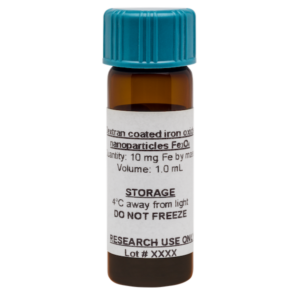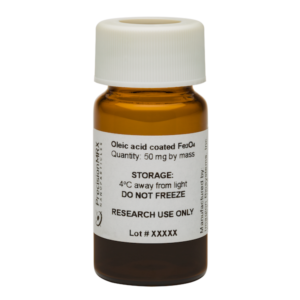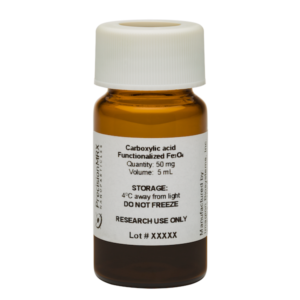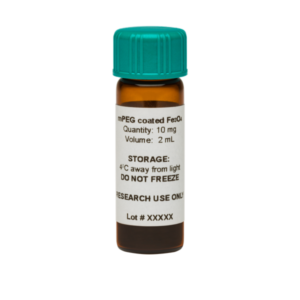SPION Applications & FAQ’s
How can superparamagnetic iron oxide nanoparticles (SPIONS) be used?
Our PrecisionMRX® iron oxide nanoparticles can be used in any application that requires superparamagnetic iron oxide nanoparticles with uniform, reproducible properties, including:
In MRI, superparamagnetic iron oxide nanoparticles enhance T2 relaxation and the observed T2* signal. Superparamagnetic iron oxide nanoparticles are used to enhance lymph node, bone marrow, and perfusion imaging. Changes in nanoparticle uptake and clearance rates from previous or expected values can indicate that changes in cellular function have occurred.
Magnetic particle imaging captures the response of superparamagnetic iron oxide nanoparticles as they relax within a transient field-free point produced between oscillating magnetic fields. Magnetic particle imaging can provide nonradioactive, real-time 3D imaging of dynamic processes such as functional heart and kidney organ activity.
Superparamagnetic iron oxide nanoparticles produce heat when exposed to an alternating magnetic field. Antibody conjugation enables targeted accumulation of nanoparticles at specific tissue sites for localized induction and application of heat by magnetically induced hyperthermia.
In magnetomotive ultrasound imaging, pulsed magnetic fields are used to induce motion of tissue-associated aggregations of magnetic nanoparticles. Traditional ultrasound imaging can then be used to locate the motion and determine the site(s) of nanoparticle aggregation.
Attaching antibody-conjugated superparamagnetic iron oxide nanoparticles to cells of interest by immune recognition allows these cells to be reversibly captured in a magnetic field for separation from unwanted cell types. Conversely, a negative enrichment strategy can deplete cell mixtures of unwanted cells by using nanoparticles conjugated to antibodies that specifically recognize unwanted cell types to remove them from a cell suspension.
Immune recognition can be used to attach antibody conjugated superparamagnetic iron oxide nanoparticles to analytes of interest. Nanoparticle-associated analytes can then be analyzed by magnetometry or immobilized for quantification using a signal-generating secondary antibody method.
When bound to biological tissue, antibody conjugated superparamagnetic iron oxide nanoparticles produce a magnetic signal as they relax following electron orbit orientation induced by a brief magnetizing pulse. The decaying magnetic signal can be detected and quantified by an array of ultrasensitive magnetic sensors yielding source location and strength. Signal amplitude and decay rate depends on nanoparticle size and size dispersion.

FAQs
General Questions
Superparamagnetism is a nanoscale phenomenon where the energy required to change the direction of the magnetic moment of a nanoparticle is comparable to the ambient thermal energy. If a sufficiently large magnetic field is applied, the spins within the material align with the field, but if the field is removed, the magnetization of the material disappears. Thus, the material behaves in a manner similar to paramagnetism, except that instead of each individual atom being independently influenced by an external magnetic field, the magnetic moment of the entire nanoparticle aligns with the magnetic field, resulting in a “giant” magnetic moment.
Reproducible production of iron oxide nanoparticles with uniform properties is very challenging. Imagion Biosystems has developed a proprietary method for manufacturing iron oxide nanoparticles with superior properties, saving your lab the extensive development time and costs associated with generating a reliable product.
PrecisionMRX® iron oxide nanoparticles are manufactured with commercially unrivaled properties including uniform size and shape with excellent crystallinity, and high magnetic susceptibility. In addition, our nanoparticle synthesis is reproducible, making your experiments reproducible as well.
Check out our Applications page for some ideas.
Technical Questions
The core component of PrecisionMRX® iron oxide nanoparticles is predominately magnetite Fe3O4. Four outer-layer coatings are available: methoxypolyethylene glycol, carboxylic acid functionalized, dextran, and oleic acid.
PrecisionMRX® iron oxide nanoparticles are 24nm – 28nm in diameter. Each batch has a narrow size dispersity of <10%.
Small angle X-ray scattering (SAXS) is used to determine the core diameter and size dispersity of each lot of PrecisionMRX® iron oxide nanoparticles. Compared to transmission electron microscopy (TEM), SAXS offers a statistically robust measure of these quantities.
Representative transmission electron microscopy (TEM), X-Ray diffraction (XRD), and magnetic susceptometry data are available upon request.
Polyethylene glycol-coated PrecisionMRX® nanoparticles can be stored as shipped in deionized water for at least six months at 4oC with no loss of colloidal stability. These nanoparticles are also stable in most buffer solutions, pH 5 – 10, such as PBS, HEPES, Tris, sodium borate, MES, etc.
Oleic acid-coated PrecisionMRX® nanoparticles can be stored dry or in a non-polar solvent (hexane, toluene, chloroform) for at least six months with no loss of colloidal stability.
Carboxylic acid functionalized PrecisionMRX® nanoparticles can be stored in deionized water for at least six months with no loss of colloidal stability. These nanoparticles are only stable in water.
Carboxylic acid functionalized PrecisionMRX® nanoparticles are available. The carboxylate functionality enables conjugation of antibody amine groups to carboxylate anions on the nanoparticle surface using EDC chemistry.
The iron oxide cores are coated with a monolayer of oleic acid and encapsulated within a monolayer of an amphiphilic copolymer.
The zeta potential for the carboxylic acid functionalized nanoparticles is between -40 and -60 mV.
Doing business with us
Custom sizes are available on request. Please submit an inquiry to sales@precisionmrx.com.
We will consider collaboration with universities or other organizations if we feel the relationship is synergistic.
Please contact us to discuss the possibility of a collaboration.
Featured Products
-
$369.00 – $660.00Price range: $369.00 through $660.00 Select options This product has multiple variants. The options may be chosen on the product page
-
$369.00 – $689.00Price range: $369.00 through $689.00 Select options This product has multiple variants. The options may be chosen on the product page
-
$450.00 – $1,679.00Price range: $450.00 through $1,679.00 Select options This product has multiple variants. The options may be chosen on the product page
-
$369.00 – $660.00Price range: $369.00 through $660.00 Select options This product has multiple variants. The options may be chosen on the product page
Transforming medical imaging for early disease detection
We’re on a mission to make cancer more detectable.














